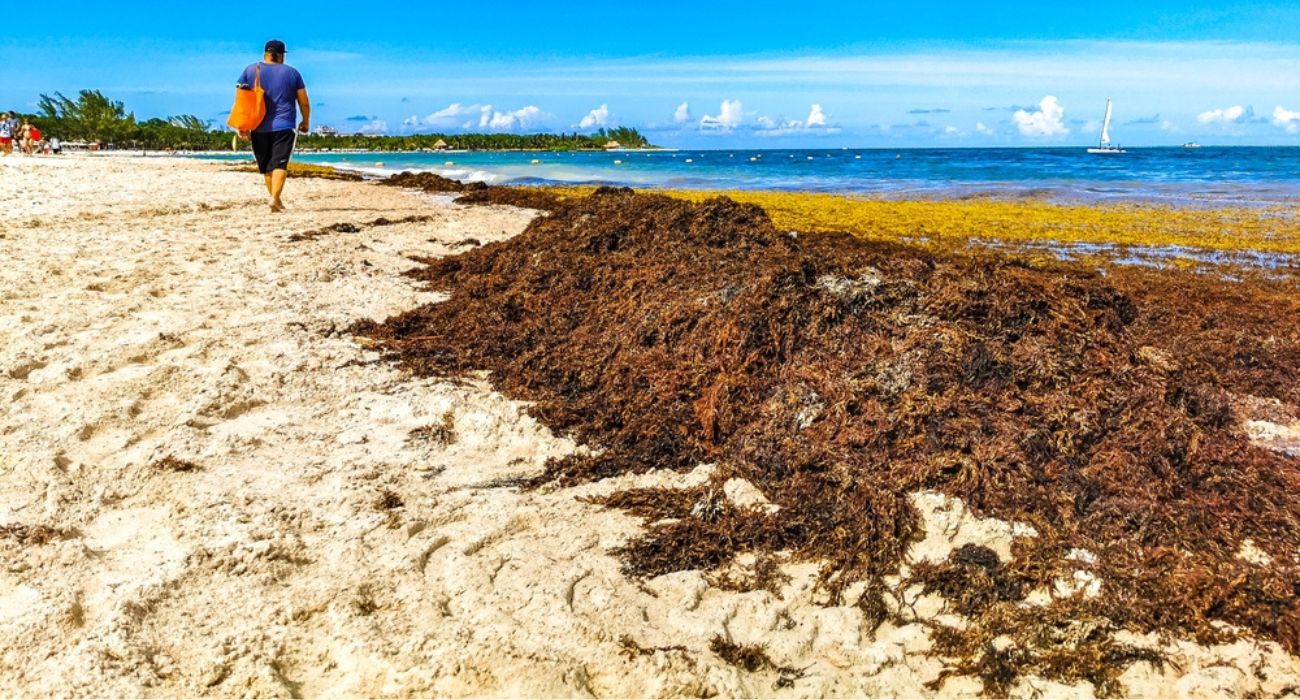The beaches of southern Florida, the Caribbean, and the Yucatán are expected to be affected by a continuous blob of seaweed in the coming months.
The Great Atlantic Sargassum Belt is a sprawling 5,000-mile expanse of seaweed that stretches from West Africa to the Gulf of Mexico.
This occurrence is not new, with the phenomenon being first observed in the Caribbean Sea in 2011. It has continued to occur at varying degrees, with some beaches on Mexico’s Caribbean coast like Playa del Carmen carpeted by mounds of smelly sargassum seaweed just last summer, per AP News.
Last year’s accumulation of more than 24 million tons of sargassum beat the all-time record set back in 2018 by 20%, the University of South Florida’s Optical Oceanography Lab reported, per AP News.
This year, scientists have estimated that the snaky belt weighs over 10 million tons.
While the effects of the sargassum washing ashore can seriously put a damper on the tourist season, it can also be problematic for people with respiratory problems and risks smothering local aquatic and coastal wildlife.
Sargassum is a type of seaweed characterized by its unique ability to float and reproduce on the water’s surface. It is thick, brown, and smells like eggs as it rots.
The origin of this seaweed can be traced to the Sargasso Sea, an enormous stretch of the Atlantic Ocean located off the southeastern coast of the United States, per The Atlanta Journal-Constitution.
Unlike other bodies of water, the Sargasso Sea is not demarcated by land boundaries, so its borders often shift, per the U.S. National Ocean Service. It is bordered to the north by the North Atlantic Current, to the south by the North Atlantic Equatorial Current, to the west by the Gulf Stream, and to the east by the Canary Current.
It is also home to a variety of sea life, including some threatened and endangered species, including humpback whales, dolphinfish, white marlin, and turtles. They use the sargassum as a breeding ground, habitat, and food source.
So, what’s the problem?
Not only can fish and turtles can be tangled up in the masses of sargassum, but when it washes ashore, it rots. This can be detrimental to coastal ecosystems and spawn harmful bacteria, per The Atlanta Journal-Constitution.
Despite extensive research, scientists have not yet been able to determine the exact reasons behind the recent substantial increase in sargassum growth.
The phenomenon is “shrouded in mystery,” Brian Lapointe, a research professor at Florida Atlantic University, told NPR.
Yet Lapointe hypothesized that it may have something to do with shifts in the nitrogen-to-phosphorus ratio.
“It’s almost like sargassum is a barometer for how global nitrogen levels are changing,” Lapointe suggested.
Sargassum is also very difficult to track, especially as it approaches the shore.
“We can see it out there in the open ocean and we can track movements offshore with accuracy,” Brian Barnes, a researcher with the University of South Florida’s College of Marine Science, told NPR. “But once you start getting into the scale of an individual beach, it becomes much more difficult.”
So far, scientists don’t believe it will wash up much on Texan shores, per ABC 13 Houston.







Seaweed can be used to make excellent, fertile soil. Seaweed holds an array of important nutrients, such as iodine.
Many cultures in the past have done this to help their crop production.
Alcohol is a very clean, non-polluting fuel. There is no black soot nor toxic chemicals which occur from burning alcohol. No gum build-up. Henry Ford first designed his cars to run on alcohol. (Remember…there were no gas stations.) Rockefeller helped to finance Prohibition in order to corner the marketplace for automobile fuel.
David Blume [book – “Alcohol Can Be A Gas”] discusses how seaweed is a wonderful cheap source for making alcohol.
And even better…there are no waste products in alcohol production. The leftover mash and even the CO2 from the manufacturing of alcohol can be directly and commercially used in the food production chain.
SOURCE Example:
Major food producer Archer-Daniels-Midland (ADM)
Queued 1:15:00
https://www.youtube.com/watch?v=ogcv9xS8Pkw&t=4500s